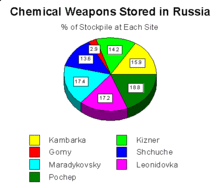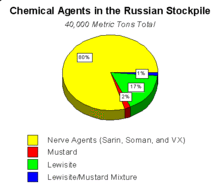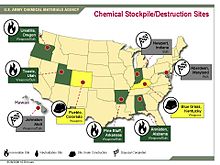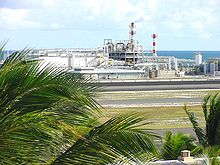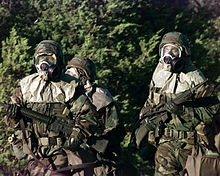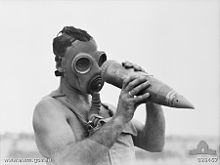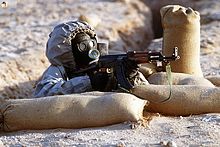- Chemical weapon
-
Chemical weapons 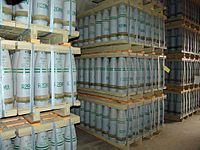
Pallets of 155 mm artillery shells containing "HD" (distilled sulfur mustard agent) at Pueblo Depot Activity (PUDA) chemical weapons storage facility.Blister Agents: (Vesicants): Phosgene Oximine (CX) Lewisite (L) Sulfur Mustard (Yperite) (HD) Nitrogen Mustard (HN) Nerve Agents: Tabun (GA) Sarin (GB) Soman (GD) Cyclosarin (GF) VX (VX) Blood Agents: Cyanogen chloride (CK) Hydrogen cyanide (AC) Choking Agents: Chloropicrin (PS) Phosgene (CG) Diphosgene (DP) Chlorine (CI) 
Soviet chemical weapons canister from an Albanian stockpile.[1] A chemical weapon (CW)[Note 1] is a device that uses chemicals formulated to inflict death or harm to human beings. They are classified as weapons of mass destruction, and have been "condemned by the civilised world". CW have been used in past conflicts—and preparedness doctrine anticipates the potential for future use. Numerous international agreements are in force with regard to chemical weapons.
Lethal unitary chemical agents and munitions are extremely volatile and constitute a class of hazardous chemical weapons stockpiled by many nations. The most dangerous of these are nerve agents GA, GB, and VX, and vesicant (blister) agents H, HT, and HD. All are in liquid form at normal room temperature. Public opinion has moved to endorse the complete elimination of this class, and progress is being made to fulfill its eradication through international law.
Contents
International law
Main article: International law"International law is the term commonly used for referring to laws that govern the conduct of independent nations in their relationships with one another."[2] They are generally regarded as binding, and State Parties accept the terms. Treaties like the Geneva Conventions requires nations assent to the terms, which often requires acts of national legislation to conform. Nations may delegate their national jurisdiction to a supranational tribunal such as the European Court of Human Rights or the International Criminal Court.
Geneva Protocol
Main article: Geneva ProtocolThe Geneva Protocol, officially known as the Protocol for the Prohibition of the Use in War of Asphyxiating, Poisonous or other Gases, and of Bacteriological Methods of Warfare, is an International treaty prohibiting the use of chemical and biological weapons. It was signed at Geneva June 17, 1925 and entered into force on February 8, 1928. 133 nations are listed as state parties[3] to the treaty—Ukraine acceded August 7, 2003 and is the most recent member nation.[4] This treaty states that chemical and biological weapons are "justly condemned by the general opinion of the civilised world." While the treaty prohibits the use of chemical, and biological weapons, it does not address the production, storage, or transfer of these weapons. Later treaties would address these omissions and have been enacted.
Main article: Washington Naval TreatyThe Washington Naval Treaty, signed February 6, 1922, also known as the Five-Power Treaty, aimed at banning CW—but did not succeed because the French rejected it. The subsequent failure to include CW has contributed to the resultant increase in stockpiles.[5]
Chemical Weapons Convention
Main article: Chemical Weapons Convention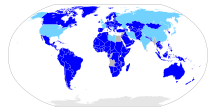 States parties to the Chemical Weapons Convention. Light colored territories are those states parties that have declared stockpiles of chemical weapons and/or have known production facilities for chemical weapons.
States parties to the Chemical Weapons Convention. Light colored territories are those states parties that have declared stockpiles of chemical weapons and/or have known production facilities for chemical weapons.
The Chemical Weapons Convention (CWC) is the most recent arms control agreement with the force of International law. Its full name is the Convention on the Prohibition of the Development, Production, Stockpiling and Use of Chemical Weapons and on their Destruction. This agreement outlaws the production, stockpiling and use of chemical weapons. It is administered by the Organisation for the Prohibition of Chemical Weapons (OPCW), an independent organization based in The Hague.[6]
The OPCW
The OPCW administers the terms of the CWC to 188 signatories which represents 98% of the global population. Of the stockpiles, 44,131 of the 71,194 tonnes declared (61.99%) have been destroyed. The OPCW has conducted 4,167 inspections at 195 chemical weapon-related and 1,103 industrial sites. These inspections have affected the sovereign territory of 81 States Parties since April 1997. Worldwide, 4,913 industrial facilities are subject to inspection provisions.[7]
Use of chemical weapons
Main article: Chemical warfare"Chemical warfare (CW) involves using the toxic properties of chemical substances as weapons. This type of warfare is distinct from Nuclear warfare and Biological warfare, which together make up NBC, the military acronym for Nuclear, Biological, and Chemical (warfare or weapons). Neither of these falls under the term conventional weapons which are primarily effective due to their destructive potential. Chemical warfare does not depend upon explosive force to achieve an objective. Rather it depends upon the unique properties of the chemical agent weaponized. A lethal agent is designed to injure or incapacitate the enemy, or deny unhindered use of a particular area of terrain. Defoliants are used to quickly kill vegetation and deny its use for cover and concealment. It can also be used against agriculture and livestock to promote hunger and starvation. With proper protective equipment, training, and decontamination measures, the primary effects of chemical weapons can be overcome."[8]
State parties with declared stockpiles
Of 188 signatory nations to the CWC, state parties listed below have also declared stockpiles, agreed to monitored disposal, and verification, and in some cases, used CW in conflict. Both military targets and civilian populations have been affected—the effected populations were not always damaged collaterally, but rather at times, the target of the attack.
China
Japan stored chemical weapons on the territory of mainland China between 1937 and 1945. The weapons mostly contained a mustard gas-lewisite mixture.[9] The weapons are classified as abandoned chemical weapons under the CWC and Japan has started their destruction in September 2010 in Nanjing using mobile destruction facilities.[10]
India
India declared its stock of chemical weapons in June 1997. India's declaration came after the entry into force of the CWC that created the OPCW. India declared a stockpile of 1044 tonnes of sulphur mustard at its possession. [11][12] On Jan 14, 1993 India became an original signatory to the CWC. By 2005, from among the six nations that had declared possession of chemical weapons, India was the only one to meet its deadline for chemical weapons destruction and for inspection of its facilities by the OPCW. By the end of 2006, India had destroyed more than 75 percent of its chemical weapons/material stockpile and was granted extension for destroying (the remaining stocks by April 2009) and was expected to achieve 100 percent destruction within that time frame.[12] On May 14 2009, India had informed the United Nations that it has destroyed its stockpile of chemical weapons.[13]
Iraq
Main article: Iraqi chemical warfareThe Organisation for the Prohibition of Chemical Weapons which oversees destruction measures has announced "The government of Iraq has deposited its instrument of accession to the Chemical Weapons Convention with the Secretary General of the United Nations and within 30 days, on 12 February 2009, will become the 186th State Party to the Convention".[14][15] Iraq has also declared stockpiles of CW, and because of their recent accession is the only State Party exempted from the destruction time-line.[16] On September 7, 2011 Mr. Hoshyar Zebari entered the OPCW headquarters, becoming the first Iraqi Foreign Minister to officially visit since the country joined the CWC.[17]
Attack on Sardasht
On June 28, 1987, Iraqi aircraft delivered what was believed to be mustard gas in an attack against the Iranian city of Sardasht. On two separate attacks against four residential areas, victims were estimated as 10 civilians dead and 650 civilians injured.[18]
Libya
Libya has used Chemical weapons under Muammar Gaddafi's regime in a war with Chad, a neighboring country. In 2003 Gaddafi agreed to ascend to the convention in exchange for "rapprochement" with western nations. At the time of the Libyan uprising against Gaddafi, Libya still controlled approximately 11.25 tons of poisonous mustard gas. Gaddafi has fled. Because of destabilization, concerns have increased regarding possibilities and likelihood that control of these agents could be lost. With terrorism as a core concern,[19] international bodies are seeking to ensure Libya is held to its obligations under the treaty.[20] Libya's post-Gaddafi National Transitional Council is cooperating with the Organization for the Prohibition of Chemical Weapons regarding the destruction of all legacy chemical weapons in the country.[21] After assessing the chemical stockpiles the Libyan government will receive a deadline from the OPCW to destroy the weapons.[22]
Russia
Russia entered the CWC with the largest declared stockpile of chemical weapons.[23] By 2010 the country had destroyed 18,241 tonnes at destruction facilities located in Gorny (Saratov Oblast) and Kambarka (Udmurt Republic)—where operations have finished—and Shchuchye (Kurgan Oblast), Maradykovsky (Kirov Oblast), Leonidovka (Penza Oblast) while installations are under construction in Pochep (Bryansk Oblast) and Kizner (Udmurt Republic).[24]
United States
The U.S. stored its chemical weapons at eight U.S. Army installations within the Continental United States (CONUS). The stockpiles were maintained in exclusion zones[25] at the following Department of Army installations (the percentages shown are reflections of amount by weight): Tooele Army Depot (TEAD), Utah (42.3% of total stockpile); Pine Bluff Arsenal (PBA), Arkansas (12%); Umatilla Depot Activity (UMDA), Oregon (11.6%); Pueblo Depot Activity (PUDA), Colorado (9.9%); Anniston Army Depot (ANAD), Alabama (7.1%); Aberdeen Proving Ground (APG), Maryland (5%); Newport Army Ammunition Plant (NAAP), Indiana (3.9%); and Blue Grass Army Depot (BGAD), Kentucky (1.6%). The remaining 6.6% was located on Johnston Atoll in the Pacific Ocean.
Currently stockpiles have been eliminated at Johnston Atoll, APG, and NAAP. Stockpiles are nearly eliminated at ANAD, UMDA,[26] PBA, and TEAD with completion scheduled for fiscal year (FY) 2012.[27] PUDA will begin elimination during FY 2015, and complete in FY 2017.[28] BGAD will be last to complete this elimination which tentative dates have not been set.[29]
U.S. policy on use
The U.S. policy on the use of chemical weapons is to reserve the right to retaliate. First use, or preemptive use, is a violation of stated policy. Only the president of the United States can authorize the first retaliatory use.[30] Official policy now reflects the likelihood of chemical weapons being used as a terrorist weapon.[31]
Manner and form
There are three basic configurations in which these agents are stored. Self-contained munitions like projectiles, cartridges, mines, and rockets. These can contain propellant and/or explosive components. The next form are aircraft-delivered munitions. This form never has an explosive component.[25] Together they comprise the two forms which have been weaponized and are ready for their intended use. The U.S. stockpile consisted of 39% of these weapon ready munitions. The final of the three forms are raw agent housed in one-ton containers. The remaining 61%[25] of the stockpile was in this form.[32] Whereas these chemicals exist in liquid form at normal room temperature,[25][33] the sulfur mustards H, and HD freeze in temperatures below 55 °F (12.8 °C). Mixing lewisite with distilled mustard lowers the freezing point to −13 °F (−25.0 °C).[30]
Higher temperatures are a bigger concern because the possibility of an explosion increases as the temperatures rise. A fire at one of these facilities would endanger the surrounding community as well as the personnel at the installations.[34] Perhaps more so for the community having much less access to protective equipment and specialized training.[35] The Oak Ridge National Laboratory conducted a study to assess capabilities and costs for protecting civilian populations during related emergencies,[36] and the effectiveness of expedient, in-place shelters.[37]
Disposal
Main article: Destruction of Chemical WeaponsUnited States
The stockpiles, which have been maintained for more than 50 years,[5] are now considered obsolete.[38] Public Law 99-145, contains section 1412 which directs the Department of Defense (DOD) to dispose of the stockpiles. This directive fell upon the DOD with joint cooperation from the Federal Emergency Management Agency (FEMA).[25] The Congressional directive has resulted in the present Chemical Stockpile Disposal Program.
Historically, chemical munitions have been disposed of by land burial, open burning, and ocean dumping (referred to as Operation CHASE).[39] However in 1969, the National Research Council (NRC) recommended that ocean dumping be discontinued. The Army then began a study of disposal technologies, including the assessment of incineration as well as chemical neutralization methods. In 1982, that study culminated in the selection of incineration technology, which is now incorporated into what is known as the baseline system. Construction of the Johnston Atoll Chemical Agent Disposal System (JACADS) began in 1985.
This was to be a full-scale prototype facility using the baseline system. The prototype was a success but there were still many concerns about CONUS operations. To address growing public concern over incineration, Congress, in 1992, directed the Army to evaluate alternative disposal approaches that might be "significantly safer", more cost effective, and which could be completed within the established time frame. The Army was directed to report to Congress on potential alternative technologies by the end of 1993, and to include in that report—"any recommendations that the National Academy of Sciences makes...".[32] In June 2007 the disposal program achieved a milestone reaching 45% destruction of the chemical weapon stockpile.[40] The Chemical Materials Agency (CMA) releases regular updates to the public regarding the status of the disposal program.[41] By October 2010, the program had reached 80% destruction status.[42]
Lethality
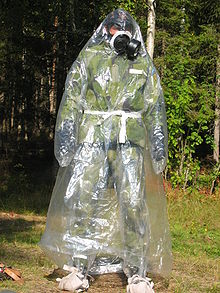 A Swedish Army soldier wearing a chemical agent protective suit (C-vätskeskydd) and protection mask (skyddsmask 90).
A Swedish Army soldier wearing a chemical agent protective suit (C-vätskeskydd) and protection mask (skyddsmask 90).
Chemical weapons are said to "make deliberate use of the toxic properties of chemical substances to inflict death".[43] At the start of World War II it was reported in newspapers that "entire regions of Europe" would be turned into "lifeless wastelands".[44] However, chemical weapons were not used to the extent feared. An unintended chemical weapon release occurred at the port of Bari. A German attack on the evening of December 2, 1943, damaged U.S. vessels in the harbour and the resultant release of mustard gas inflicted a total of 628 casualties.[45][46][47]
The U.S. Government was highly criticized for exposing American service members to chemical agents while testing the effects of exposure. These tests were often performed without the consent or prior knowledge of the soldiers affected.[48] Many Australian service personnel were also exposed as a result of the "Brook Island trials"[49] carried out by the British Government to determine the likely consequences of chemical attack in tropical conditions, about which little was then known. Some chemical agents are designed to produce mind altering changes rendering the victim unable to perform their assigned mission. These are classified as incapacitating agents and lethality is not a factor of their effectiveness.[50]
Unitary
Unitary munitions are opposite of binary munitions which contain two, unmixed and isolated non-lethal chemicals. These do not react to produce lethal effects until mixed, usually just prior to battlefield use. In contrast, unitary weapons are lethal chemical munitions which produce a toxic result in their existing state.[51] The majority of the chemical stockpile is unitary and most of it is stored in one-ton bulk containers.[52][53]
See also
- 1990 Chemical Weapons Accord
- General Purpose Criterion
- List of chemical warfare agents
References
- ^ Types of Chemical Weapons, Federation of American Scientists (FAS), http://www.fas.org/cw/documents/cwagents.pdf
- ^ Quote from main article
- ^ "Geneva Protocol reservations". Archives.sipri.org. http://archives.sipri.org/contents/expcon/cbwarfare/cbw_research_doc/cbw_historical/cbw-hist-geneva-res.html. Retrieved 2011-09-15.
- ^ "High Contracting Parties to the Geneva Protocol". Archives.sipri.org. http://archives.sipri.org/contents/expcon/cbwarfare/cbw_research_doc/cbw_historical/cbw-hist-geneva-parties.html. Retrieved 2011-09-15.
- ^ a b "United States of America: Chemical Weapons Profile | Institute for Defence Studies and Analyses". Idsa.in. http://www.idsa.in/cbwmagazine/UnitedStatesofAmericaChemicalWeaponsProfile_skshrivastav_0110. Retrieved 2010-08-09.
- ^ STATUS AS AT : 07-11-2010 01:48:46 EDT, CHAPTER XXVI, DISARMAMENT, United Nations Treaty Collection, http://treaties.un.org/Pages/ViewDetails.aspx?src=TREATY&mtdsg_no=XXVI-3&chapter=26&lang=en
- ^ "Organisation for the Prohibition of Chemical Weapons". Opcw.org. http://www.opcw.org/. Retrieved 2011-09-15.
- ^ Summary from main article
- ^ "Abandoned Chemical Weapons (ACW) in China". NTI.org. 2004-06-02. Archived from the original on 2007-07-30. http://www.nti.org/db/china/acwpos.htm. Retrieved 2010-09-17.
- ^ "Ceremony Marks Start of Destruction of Chemical Weapons Abandoned by Japan in China". OPCW. 2010-09-08. http://www.opcw.org/news/article/ceremony-marks-start-of-destruction-of-chemical-weapons-abandoned-by-japan-in-china/. Retrieved 2010-09-17.
- ^ India declares its stock of chemical weapons
- ^ a b Dominican Today - India to destroy chemical weapons stockpile by 2009
- ^ Zee News - India destroys its chemical weapons stockpile
- ^ Iraq Joins the Chemical Weapons Convention, The Organisation for the Prohibition of Chemical Weapons, http://www.opcw.org/news/article/iraq-joins-the-chemical-weapons-convention
- ^ "Iraq Designates National Authority For The Chemical Weapons Convention". Opcw.org. http://www.opcw.org/news/article/iraq-designates-national-authority-for-the-chemical-weapons-convention/. Retrieved 2011-09-15.
- ^ Schneidmiller, Chris. "NTI: Global Security Newswire - Iraq Joins Chemical Weapons Convention". Global Security Newswire. http://www.globalsecuritynewswire.org/gsn/nw_20090114_3530.php. Retrieved 2011-09-15.
- ^ "Minister of Foreign Affairs of Iraq Visits the OPCW to Discuss Implementation of the Chemical Weapons Convention". Opcw.org. 2011-09-07. http://www.opcw.org/file/minister-of-foreign-affairs-of-iraq-visits-the-opcw-to-discuss-implementation-of-the-chemical-weapons-convention/. Retrieved 2011-09-15.
- ^ "Iran Profile - Chemical Chronology 1987". Nuclear Threat Initiative. October 2003. Archived from the original on 2007-04-16. http://web.archive.org/web/20070416101720/http://www.nti.org/e_research/profiles/Iran/Chemical/2340_2959.html. Retrieved 2007-07-01.
- ^ http://www.vertic.org/media/assets/TV/TV131Final2.pdf
- ^ "Gaddafi’s chemical weapons spark renewed worries". The Washington Post. 2011-08-16. http://www.washingtonpost.com/world/middle-east/gaddafis-chemical-weapons-spark-renewed-worries/2011/09/07/gIQA4TBVAK_story.html. Retrieved 2011-09-15.
- ^ http://www.spacewar.com/reports/Libyas_NTC_pledges_to_destroy_chemical_weapons_OPCW_999.html
- ^ http://www.spacewar.com/reports/Chemical_weapons_inspectors_to_return_to_Libya_999.html
- ^ Converting Former Soviet Chemical Weapons Plants, Jonathan B. Tucker, http://cns.miis.edu/npr/pdfs/tucker41.pdf
- ^ "Russia profile". NTI.org. 2009. http://www.nti.org/e_research/profiles/russia/chemical/index.html/. Retrieved 2010-09-17.
- ^ a b c d e Public Law 99-145 Attachment E, http://www.fema.gov/pdf/plan/6-ch-e.pdf
- ^ Umatilla Chemical Depot (press release), U.S. Army Chemical Materials Agency, August 10, 2010, http://www.cma.army.mil/fndocumentviewer.aspx?DocID=003683438
- ^ News Release, U.S. Army Chemical Materials Agency, June 6, 2009, http://www.cma.army.mil/fndocumentviewer.aspx?docid=003680954
- ^ The U.S. Army Chemical Materials Agency (CMA) - Pueblo, Colorado, Cma.army.mil, http://www.cma.army.mil/pueblo.aspx, retrieved 2010-08-09
- ^ Getting chemical weapons destruction back on track | Bulletin of the Atomic Scientists, Thebulletin.org, 2009-04-27, http://www.thebulletin.org/web-edition/op-eds/getting-chemical-weapons-destruction-back-track, retrieved 2010-08-09
- ^ a b (PDF) FM 3-9 (field manual), http://www.globalsecurity.org/wmd/library/policy/army/fm/3-9/fm3-9.pdf, retrieved 2010-08-10
- ^ (PDF) FM 8-285 (field manual), http://www.globalsecurity.org/wmd/library/policy/army/fm/8-285/ch1.pdf, retrieved 2010-08-10
- ^ a b Chemical Stockpile Disposal Program Final Programmatic Environmental Impact Statement Volume 3: Appendices A-S - Storming Media, Stormingmedia.us, http://www.stormingmedia.us/06/0636/A063674.html, retrieved 2010-08-09
- ^ RECORD VERSION WRITTEN STATEMENT BY CARMEN J. SPENCER DEPUTY ASSISTANT SECRETARY OF THE ARMY, http://homeland.house.gov/SiteDocuments/20100615101417-64589.pdf
- ^ EVALUATING PROTECTIVE ACTIONS FOR CHEMICAL AGENT EMERGENCIES, U.S. Department of the Army, April 1990, http://emc.ornl.gov/EMCWeb/EMC/PDF/EvalDocFinal.pdf
- ^ Methods for Assessing and Reducing Injury from Chemical Accidents, John Wiley & Sons Ltd, http://dge.stanford.edu/SCOPE/SCOPE_40/SCOPE_40_2.6_McQuaid_157-188.pdf
- ^ Technical Options for Protecting Civilians from Toxic Vapors and Gases, Oak Ridge National Laboratory, http://www.ornl.gov/info/reports/1988/3445602739936.pdf
- ^ Effectiveness of expedient sheltering in place in a residents, Journal of Hazardous Materials, Elsiver.com, http://www.epa.gov/nhsrc/pubs/paperSIP010406.pdf
- ^ John Pike. "Chemical Weapons". Globalsecurity.org. http://www.globalsecurity.org/wmd/intro/cw.htm. Retrieved 2010-08-09.
- ^ John Pike. "Operation CHASE (for "Cut Holes and Sink 'Em")". Globalsecurity.org. http://www.globalsecurity.org/military/ops/chase.htm. Retrieved 2010-08-09.
- ^ 45 Percent CWC Milestone, U.S. Army Chemical Materials Agency, http://www.cma.army.mil/fndocumentviewer.aspx?docid=003676901
- ^ Agent Destruction Status, United States Army Chemical Materials Agency, http://www.cma.army.mil/verticalmetricswindow.aspx?graph=Agent&desc=Agent%20Destruction%20Status
- ^ CMA Reaches 80% Chemical Weapons Destruction Mark, Cma.army.mil, http://www.cma.army.mil/fndocumentviewer.aspx?DocID=003683572, retrieved 2010-11-07
- ^ "TextHandbook-EforS.fm" (PDF). http://www.unidir.org/pdf/articles/pdf-art2059.pdf. Retrieved 2010-08-09.
- ^ "[2.0] A History Of Chemical Warfare (2)". Vectorsite.net. http://www.vectorsite.net/twgas_2.html. Retrieved 2010-08-09.
- ^ "Mustard Disaster at Bari". Fhp.osd.mil. http://fhp.osd.mil/CBexposures/ww2mustard.jsp. Retrieved 2010-08-09.
- ^ "Naval Armed Guard: at Bari, Italy". History.navy.mil. http://www.history.navy.mil/faqs/faq104-4.htm. Retrieved 2010-08-09.
- ^ Text of the Biological and Toxin Weapons Convention, http://www.brad.ac.uk/acad/sbtwc/keytext/genprot.htm
- ^ "IS MILITARY RESEARCH HAZARDOUS TO VETERANS' HEALTH? LESSONS SPANNING HALF A CENTURY. UNITED STATES SENATE, DECEMBER 8, 1994". Gulfweb.org. http://www.gulfweb.org/bigdoc/rockrep.cfm. Retrieved 2010-08-09.
- ^ "Brook Island Trials of Mustard Gas during WW2". Home.st.net.au. http://home.st.net.au/~dunn/brook%20island%20trial.htm. Retrieved 2010-09-15.
- ^ "007 Incapacitating Agents". Brooksidepress.org. http://www.brooksidepress.org/Products/OperationalMedicine/DATA/operationalmed/Manuals/RedHandbook/007IncapacitatingAgents.html. Retrieved 2010-08-09.
- ^ Alternative technologies for the destruction of chemicam agents and munitions, National Research Council (U.S.), http://books.google.com/books?id=S2cJLoEvIaAC&pg=PA22&lpg=PA22&dq=Lethal+Unitary+Chemical+Agents+and+Munitions+%22soviet%22&source=bl&ots=6aIK4lz5cP&sig=nHyySvAvP2ubr8Z9CT5axsmtaEw&hl=en&ei=SdJxTI6aDYK88gbRhuDyCw&sa=X&oi=book_result&ct=result&resnum=6&ved=0CCUQ6AEwBQ#v=onepage&q&f=false
- ^ "Beyond the Chemical Weapons Stockpile: The Challenge of Non-Stockpile Materiel". Armscontrol.org. http://www.armscontrol.org/print/363. Retrieved 2010-08-10.
- ^ Veterans at Risk: the health effects ... - Google Books. Books.google.com. 2002-02-22. ISBN 9780309048323. http://books.google.com/?id=UMJw_6sx1jIC&pg=PA49&lpg=PA49&dq=lethal+unitary#v=onepage&q=lethal%20unitary&f=false. Retrieved 2010-08-10.
Footnotes
- ^ This article focuses on chemical weapon technologies and handling from the industrial period, beginning circa 1900's
External links
Canada specific
- The Government of Canada ""Challenge"" for chemical substances that are a high priority for action, http://www.chemicalsubstanceschimiques.gc.ca/challenge-defi/index-eng.php
US specific
- Chemical categories, http://www.bt.cdc.gov/agent/agentlistchem-category.asp
- Chemical Stockpile Emergency Preparedness Program (home page), http://emc.ornl.gov/CSEPPweb/FEMACSEPPHome.html
- Chemical Warfare Agents, http://sis.nlm.nih.gov/enviro/chemicalwarfare.html#a1
- U.S. Army Chemical Materials Agency (home page), http://www.cma.army.mil/home.aspx
Categories:- Aftermath of war
- Chemical weapons
- Chemical weapons demilitarization
- Military terminology
- Weapons of mass destruction
Wikimedia Foundation. 2010.

